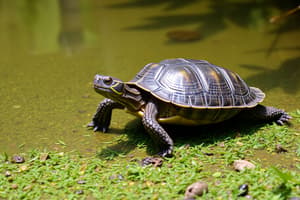Podcast
Questions and Answers
What defines the Class Reptilia?
What defines the Class Reptilia?
- Only land-dwelling animals
- Birds and mammals
- Amphibians
- Lizards, snakes, turtles, crocodiles (correct)
What feature is common in the body of reptiles?
What feature is common in the body of reptiles?
- Covered with feathers
- Soft and moist skin
- Covered with keratinized epidermal scales (correct)
- Primarily composed of hair
What type of limbs do reptiles usually have?
What type of limbs do reptiles usually have?
Two pairs with five toes
Reptiles possess gills for respiration.
Reptiles possess gills for respiration.
How does the circulatory system of reptiles function?
How does the circulatory system of reptiles function?
What type of fertilization do most reptiles undergo?
What type of fertilization do most reptiles undergo?
Which of the following is a characteristic of the metanephric kidney found in reptiles?
Which of the following is a characteristic of the metanephric kidney found in reptiles?
What is temperature-dependent sex determination?
What is temperature-dependent sex determination?
What is one defining feature of the subclass Anapsida?
What is one defining feature of the subclass Anapsida?
Which group of reptiles includes snakes?
Which group of reptiles includes snakes?
What is the common feature of the eggs in oviparous reptiles?
What is the common feature of the eggs in oviparous reptiles?
Flashcards are hidden until you start studying
Study Notes
Class Reptilia
- Includes lizards, snakes, turtles, and crocodiles.
- Approximately 9500 species; classified as a paraphyletic group.
- Characterized by scaly skin, ectothermic physiology, and amniotic egg development.
Body Structure
- Covered with keratinized epidermal scales and limited epidermal glands.
- Some reptiles possess bony dermal plates.
Limbs
- Typically have two pairs with five toes, except for snakes, some lizards, and amphisbaenians which lack limbs.
Skeleton
- Structure is well ossified with ribs and a sternum forming a thoracic basket, absent in snakes.
Respiratory System
- Possess lungs that are more developed than those of amphibians and lack gills.
Circulatory System
- Double circulatory system consisting of pulmonary and systemic circuits.
- Heart structure varies between three or four chambers.
Ectothermy
- Utilize behavioral thermoregulation to maintain body temperature.
Excretory System
- Metanephric kidneys excrete waste as uric acid.
Nervous System
- Enhanced brain structure with enlarged cerebrum and cerebellum.
Reproductive System
- Dioecious, exhibiting internal fertilization.
- Can be oviparous, ovoviviparous, or viviparous with no larval stages.
Eggs
- Oviparous species have calcareous or leathery shells, while ovoviviparous have shells absent and viviparous species develop young with placentas.
Temperature-Dependent Sex Determination
- Observed in crocodiles, turtles, and some lizards, where the incubation temperature dictates the sex of offspring.
- Two patterns:
- Some turtles - low temp results in males; high temp in females.
- Crocodilians and others - low temp results in females; high temp in males, with higher temps leading to more females.
Comparison with Amphibians
- Reptiles have tough, dry scaly skin, jaws designed for crushing, and well-developed lungs.
- Amphibians possess soft, moist skin with external fertilization, prone to water loss.
Major Extant Reptile Groups
- Anapsida: Turtles with skulls lacking temporal openings.
- Diapsida: Includes lizards, snakes, crocodilians, and birds, characterized by skulls with two temporal openings.
- Synapsida: Represents mammals with one lateral temporal opening.
Order Testudines (Turtles)
- Over 300 species globally, except polar regions.
- Encased in a bony shell comprising the carapace (dorsal) and plastron (ventral).
- Lay eggs on land with jaws featuring keratinized beaks.
Order Squamata (Lizards, Snakes, Worm Lizards)
- Divided into suborders Lacertilia (lizards), Serpentes (snakes), and Amphisbaenia (worm lizards).
Suborder Lacertilia (Lizards)
- Comprises about 5600 species with slender bodies, usually four limbs (glass lizards are limb-less) and regenerative tails.
Suborder Amphisbaenia (Worm Lizards)
- Around 130 species that are limbless and resemble worms, living primarily in South America and tropical Africa.
Suborder Serpentes (Snakes)
- Encompasses 3400 species, characterized by lack of limbs, reduced left lung, and unique jaw mechanics allowing them to swallow prey whole.
Order Sphenodonta (Tuataras)
- Found in New Zealand with only two remaining species considered "living fossils."
- Possess a third eye under the skin, known as the parietal eye, with unknown functions.
Order Crocodilia (Crocodiles and Alligators)
- Includes both crocodiles and alligators with distinct morphological and behavioral traits.
Studying That Suits You
Use AI to generate personalized quizzes and flashcards to suit your learning preferences.




